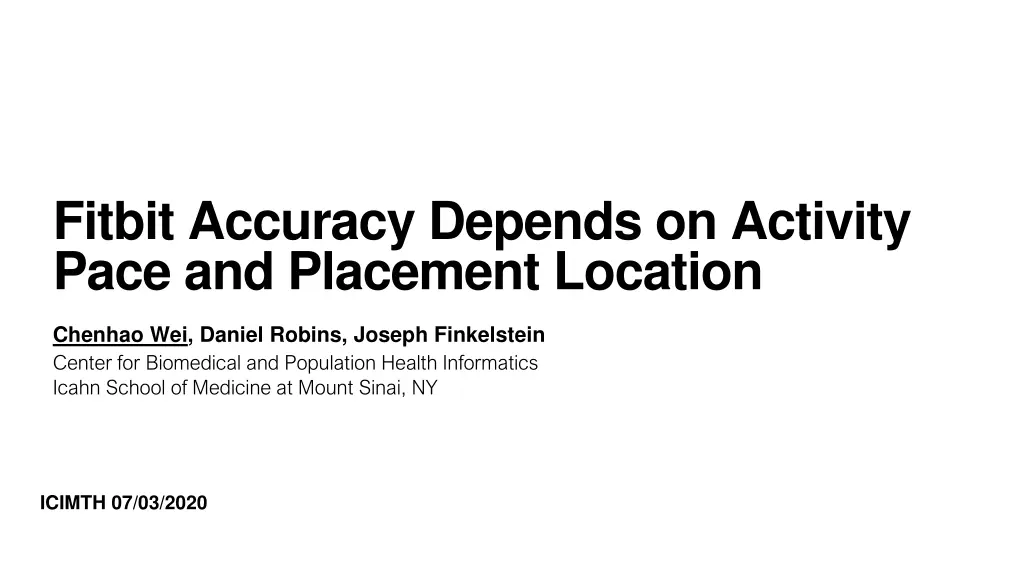
Fitbit Accuracy Study: Activity Pace & Placement Impact
Investigating the accuracy of Fitbit trackers based on activity pace and placement location. Results show variability in step counts, particularly at different movement speeds and placement locations on the body. Wearable devices may not be optimal for tracking step counts in certain populations.
Download Presentation

Please find below an Image/Link to download the presentation.
The content on the website is provided AS IS for your information and personal use only. It may not be sold, licensed, or shared on other websites without obtaining consent from the author. If you encounter any issues during the download, it is possible that the publisher has removed the file from their server.
You are allowed to download the files provided on this website for personal or commercial use, subject to the condition that they are used lawfully. All files are the property of their respective owners.
The content on the website is provided AS IS for your information and personal use only. It may not be sold, licensed, or shared on other websites without obtaining consent from the author.
E N D
Presentation Transcript
Fitbit Accuracy Depends on Activity Pace and Placement Location Chenhao Wei, Daniel Robins, Joseph Finkelstein Center for Biomedical and Population Health Informatics Icahn School of Medicine at Mount Sinai, NY ICIMTH 07/03/2020
Study Object and Background Introduction Wearable fitness trackers are an increasingly popular consumer item, but lack of evidence that demonstrates how these sensors have been tested and validated. Prior studies have demonstrated significant variability of step counts using pedometer functions from multiple manufacturers. Measurements may be influenced by health status of the wearer, gait, speed of movement, indoor/outdoor walking, and presence of stairs, among many other conditions.
Study Object and Background Study Object This study is designed to investigate how step count results from Fitbit fitness trackers may vary depending on: Their locations on the body. The speed of movement as participants climb and descend stairs.
Method Study Design Nine healthy adults (7 males, 2 females, all right-handed). Perform 3 phases of stair climbing: Slow Medium Fast Concurrently wear 5 Fitbit activity trackers. Analyze the data with one-way ANOVA analysis method.
Method System Design
Results Pace Variance SD MAX-MIN % Mean Slow 1770.9 3307.5 27.6 27.1 73.0 63.1 44.5 61.0 Medium 25.9 24.5 4.0 2.3 10.8 5.9 8.6 6.3 Fast 113.1 106.7 8.7 4.0 23.3 10.5 26.2 15.8 Variability of step reporting depending on Fitbit placement and climbing pace (Mean SD)
Results Average step counts by tracker location, for each pace.
Discussion Wearable devices are poorly suited to track step counts for patients with limited mobility, advanced age, or even novices just beginning an exercise regimen. On these particular activity trackers, step count results for anyone moving at a pace other than medium pace may be sub-optimal. The implications of such extreme variance are amplified further when combining step counts across multiple paces; results from a single session with multiple speeds (e.g. interval training) and/or analyzing results longitudinally across multiple sessions (e.g. tracking progress) should be taken in context.
Discussion Interestingly, in our population of all right-handed participants, results from Right Wrist were frequently lower than the readings acquired from Left Wrist and other locations on the body. This trend is more pronounced at the slow and fast paces. It is possible that this reflects less arm movement of the main arm; this arm is more steady with less shaking, or perhaps the arm and hand are held in a position to grab the handrail and brace in case of a sudden fall.
Discussion These results highlight the need for transparency and review of the validation studies of wearables sensors before their use is considered in a professional context. Studies of patients with chronic obstructive pulmonary disease and multiple sclerosis suggest that these patients in particular may benefit from decisions informed by wearables data. However, there must be a thorough understanding of data quality before appropriate data-driven decisions can be made.
Acknowledgements This study was supported in part by a grant R61HL143317 from the National Institutes of Health.






















